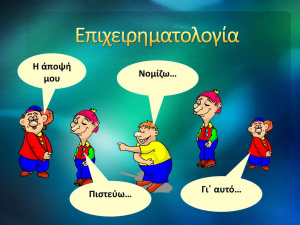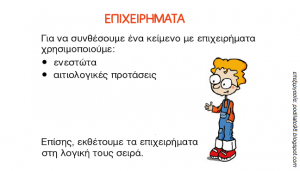Difference between revisions of "Language/Modern-greek-1453/Grammar/Methods-of-Argument"
m (Quick edit) |
|||
| (2 intermediate revisions by 2 users not shown) | |||
| Line 1: | Line 1: | ||
[[File:Greek-Language-PolyglotClub.png|thumb]] | [[File:Greek-Language-PolyglotClub.png|thumb]] | ||
<div | <div class="pg_page_title"> Methodology of the argument in Greek</div> | ||
__TOC__ | __TOC__ | ||
[[File:Επιχειρηματολογία+Η+άποψή+μου+Νομίζω…+Γι΄+αυτό…+Πιστεύω….jpg|thumb]] | [[File:Επιχειρηματολογία+Η+άποψή+μου+Νομίζω…+Γι΄+αυτό…+Πιστεύω….jpg|thumb]] | ||
== '''English: Methodology of the argument''' == | == '''English: Methodology of the argument''' == | ||
To develop an idea orally or in writing, you will need to use very specific diagrams that will allow you to introduce, develop and conclude your presentation.. | To develop an idea orally or in writing, you will need to use very specific diagrams that will allow you to introduce, develop and conclude your presentation.Successful language comprehension is a cognitively challenging process that requires a number of different but interrelated processes such as vocabulary knowledge and retrieval syntactic , and semantic processing , as well as discourse and pragmatic integration. Syntactic and semantic processing of sentences is crucial to successful language comprehension. | ||
Introduce and conclude an argument. | Introduce and conclude an argument. | ||
| Line 64: | Line 64: | ||
*'''ασήμαντο.'''.. insignificant ... | *'''ασήμαντο.'''.. insignificant ... | ||
== '''French: Méthodologie de l'argumentation''' == | == '''French: Méthodologie de l'argumentation''' == | ||
| Line 126: | Line 125: | ||
*'''ασήμαντο.'''..insignifiant ... | *'''ασήμαντο.'''..insignifiant ... | ||
[[File:podilato98-epixeirimatologia_grammatiki.PNG|thumb|none]] | [[File:podilato98-epixeirimatologia_grammatiki.PNG|thumb|none]] | ||
| Line 162: | Line 158: | ||
'''Γι’ αυτό... Έτσι... Κατά συνέπεια... Επομένως... δε συμφωνείτε ότι... είναι κρίμα να... είναι άσχημο … ευχάριστο… σπουδαίο … ασήμαντο..''' | '''Γι’ αυτό... Έτσι... Κατά συνέπεια... Επομένως... δε συμφωνείτε ότι... είναι κρίμα να... είναι άσχημο … ευχάριστο… σπουδαίο … ασήμαντο..''' | ||
==Sources== | ==Sources== | ||
| Line 173: | Line 165: | ||
* Voluntary contribution aimed at helping people, all over the world, who are committed to learning the Greek language ! | * Voluntary contribution aimed at helping people, all over the world, who are committed to learning the Greek language ! | ||
==Other Lessons== | |||
* [[Language/Modern-greek-1453/Grammar/Contract-Verbs|Contract Verbs]] | |||
* [[Language/Modern-greek-1453/Grammar/Relative-Pronouns|Relative Pronouns]] | |||
* [[Language/Modern-greek-1453/Grammar/The-Greek-sentence-types|The Greek sentence types]] | |||
* [[Language/Modern-greek-1453/Grammar/Augment-in-modern-Greek|Augment in modern Greek]] | |||
* [[Language/Modern-greek-1453/Grammar/Demonstrative-Pronouns|Demonstrative Pronouns]] | |||
* [[Language/Modern-greek-1453/Grammar/Irregular-adjectives|Irregular adjectives]] | |||
* [[Language/Modern-greek-1453/Grammar/Verb-To-Be|Verb To Be]] | |||
* [[Language/Modern-greek-1453/Grammar/Pronouns|Pronouns]] | |||
* [[Language/Modern-greek-1453/Grammar/Greek-Deponent-Verbs|Greek Deponent Verbs]] | |||
* [[Language/Modern-greek-1453/Grammar/The-predicate|The predicate]] | |||
<span links></span> | |||
Latest revision as of 13:14, 27 March 2023
English: Methodology of the argument[edit | edit source]
To develop an idea orally or in writing, you will need to use very specific diagrams that will allow you to introduce, develop and conclude your presentation.Successful language comprehension is a cognitively challenging process that requires a number of different but interrelated processes such as vocabulary knowledge and retrieval syntactic , and semantic processing , as well as discourse and pragmatic integration. Syntactic and semantic processing of sentences is crucial to successful language comprehension.
Introduce and conclude an argument.
1 . I start with:[edit | edit source]
- Η άποψή μου είναι ...: My opinion is ...:
- Η γνώμη μου είναι ...: in my estimate
- Πιστεύω ότι ...: I believe ...
- Νομίζω ότι ...: I think so ...
- Θεωρώ πως ...: I consider that ..
2 . You can add elements[edit | edit source]
- γιατί : why?
- επειδή : because
- αφού... since
3 . I put other ideas in parallel or to compare to express my feelings:[edit | edit source]
- Είναι κρίμα να ...: It's a shame to ...
- Είναι άσχημο ...: It's ugly
- Είναι ευχάριστο ... It's nice ...
- Είναι σπουδαίο ... It's great ...
- Είναι ασήμαντο ... It is insignificant ...
- Δε συμφωνείτε ότι ...; Don't you agree that ...?
4. To determine that what we believe continues and is still sustainable, it is important to use the present indicative[edit | edit source]
5 .I conclude :[edit | edit source]
- Γι’ αυτό... So...
- Έτσι... Therefore...
- Κατά συνέπεια... as a consequence
- δε συμφωνείτε ότι... you don't agree that ..
- είναι κρίμα να….. it's a shame to ...
- είναι άσχημο … It's ugly…
- ευχάριστο… pleasant…
- σπουδαίο … Great …
- ασήμαντο... insignificant ...
French: Méthodologie de l'argumentation[edit | edit source]
Pour développer une idée à l'oral ou à l'écrit, il vous faudra utiliser des schémas bien précis qui vous permettront d'introduire, de développer et de conclure votre exposé.
Introduire et conclure une argumentation.
1 . Je débute par :[edit | edit source]
- Η άποψή μου είναι... : Mon opignion est... :
- Η γνώμη μου είναι... : à mon avis
- Πιστεύω ότι... : Je pense que...
- Νομίζω ότι... : Je crois que...
- Θεωρώ πως...: Je considère que .
2 . Puis j'ajoute des éléments :[edit | edit source]
- γιατί : Pourquoi
- επειδή : car, parce que
- αφού... : Puisque
3 . Je mets d'autres idées en parallèle ou pour comparer ου d'exprimer mes sentiments :[edit | edit source]
- Είναι κρίμα να... : C'est dommage de...
- Είναι άσχημο...: C'est moche
- Είναι ευχάριστο... C'est agréable ...
- Είναι σπουδαίο... C'est super...
- Είναι ασήμαντο... C'est insignifiant...
- Δε συμφωνείτε ότι...; N'êtes-vous pas d'accord que ...?
4 . Pour déterminer dont ce que nous croyons continue et il est encore durable, c'est important l'emploi d'indicatif présent. [edit | edit source]
5 . Je conclus :[edit | edit source]
- Γι’ αυτό... Pour ça...
- Έτσι... Donc...
- Κατά συνέπεια... Par conséquent....
- δε συμφωνείτε ότι... vous n'êtes pas d'accord que...
- είναι κρίμα να... c'est dommage de...
- είναι άσχημο … C'est moche…
- ευχάριστο… agréable…
- σπουδαίο …super …
- ασήμαντο...insignifiant ...
Greek: Πώς γράφουμε επιχειρηματολογία κειμένου[edit | edit source]
Αν και εκφράζουμε συχνά τη γνώμη μας (θετική ή αρνητική) για κάποιο θέμα, δεν το κάνουμε πάντοτε με τον σωστό τρόπο.
Πολλές φορές προσπαθούμε να πείσουμε τους άλλους για την άποψή μας χωρίς να έχουμε ένα απαραίτητο «εφόδιο»: επιχειρήματα!
Οι συνομιλητές μας θα πειστούν για την ορθότητα της γνώμης μας μόνο αν χρησιμοποιήσουμε τα κατάλληλα επιχειρήματα, αν δηλαδή έχουμε κάθε φορά
τη σωστή επιχειρηματολογία. Διαφορετικά ο καθένας λέει τα δικά του και η συζήτηση ναυαγεί...
Για να πείσουμε κάποιον ότι έχουμε δίκιο και ότι η άποψή μας είναι σωστή:
1. Αρχικά αναφέρουμε ποια είναι η άποψή μας, λέμε ποια είναι η θέση μας πάνω στο συγκεκριμένο ζήτημα.[edit | edit source]
Χρησιμοποιούμε φράσεις όπως: Η άποψή μου είναι... Η γνώμη μου είναι... Πιστεύω ότι... Νομίζω ότι... Θεωρώ πως... κ.ά.
2 .Στη συνέχεια αναλύουμε ένα ένα τα επιχειρήματά μας, δηλαδή τις προτάσεις που στηρίζουν λογικά τις απόψεις μας.[edit | edit source]
Παρουσιάζουμε τους συλλογισμούς μας, φροντίζοντας κάθε φορά να τους δικαιολογούμε με τις κατάλληλες αιτιολογικές προτάσεις : γιατί, επειδή, αφού....
3 .Ταυτόχρονα χρησιμοποιούμε φράσεις που δηλώνουν τα συναισθήματά μας ή φράσεις με τις οποίες προσπαθούμε να προκαλέσουμε κάποια ανάλογα συναισθήματα σε αυτόν[edit | edit source]
που μας ακούει ή μας διαβάζει.
Παραδείγματα: Είναι κρίμα να... Είναι άσχημο... Είναι ευχάριστο... Είναι σπουδαίο... Είναι ασήμαντο... Δε συμφωνείτε ότι...;
4 . Για να δηλώσουμε ότι αυτό που πιστεύουμε έχει καθολική και διαρκή ισχύ στηριζόμαστε στην οριστική του ενεστώτα.[edit | edit source]
5 .Τέλος, καταλήγουμε σε ένα αιτιολογημένο και λογικό συμπέρασμα με τη βοήθεια λέξεων και φράσεων όπως: [edit | edit source]
Γι’ αυτό... Έτσι... Κατά συνέπεια... Επομένως... δε συμφωνείτε ότι... είναι κρίμα να... είναι άσχημο … ευχάριστο… σπουδαίο … ασήμαντο..
Sources[edit | edit source]
- Ευγενική χορηγία που στοχεύει να βοηθήσει μαθητές ή μη, απανταχού της Γης, που επιδίδονται στην εκμάθηση της ελληνικής γλώσσας!
- Contribution bénévole visant à aider les personnes, partout dans le monde, qui sont engagées dans l'apprentissage de la langue grecque !
- Voluntary contribution aimed at helping people, all over the world, who are committed to learning the Greek language !
Other Lessons[edit | edit source]
- Contract Verbs
- Relative Pronouns
- The Greek sentence types
- Augment in modern Greek
- Demonstrative Pronouns
- Irregular adjectives
- Verb To Be
- Pronouns
- Greek Deponent Verbs
- The predicate


